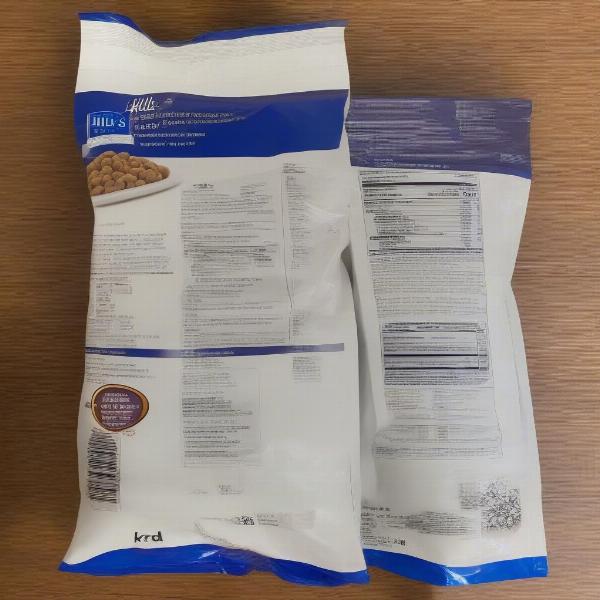K&D dog food is a prescription diet formulated by Hill’s Pet Nutrition specifically for dogs with kidney disease. Understanding the importance of this specialized diet is crucial for managing your dog’s health and improving their quality of life. This guide will explore the benefits, ingredients, feeding guidelines, and frequently asked questions surrounding K&D dog food.
Choosing the right food for a dog with kidney problems can be challenging. Regular dog foods often contain high levels of protein, phosphorus, and sodium, which can exacerbate kidney issues. K&D, on the other hand, is designed to support kidney function by carefully controlling these nutrients.
Understanding Kidney Disease in Dogs
Kidney disease, or chronic kidney failure (CKF), is a common health problem in older dogs. The kidneys play a vital role in filtering waste products from the blood. When kidney function declines, these toxins build up, leading to a variety of health issues. Symptoms of kidney disease can include increased thirst, frequent urination, loss of appetite, vomiting, and lethargy.
 K&D Dog Food Packaging
K&D Dog Food Packaging
Benefits of K&D Dog Food
K&D is clinically proven to support kidney health in dogs. Its controlled phosphorus levels help reduce the workload on the kidneys, while its reduced protein content helps minimize the buildup of waste products in the bloodstream. The added antioxidants in K&D also help protect against cell damage caused by free radicals.
Key Features of K&D:
- Controlled Phosphorus: Reduces the strain on the kidneys.
- Reduced Protein: Minimizes waste product buildup.
- Enhanced Palatability: Encourages consumption even with decreased appetite.
- Added Antioxidants: Supports overall health and protects against cell damage.
- Omega-3 Fatty Acids: Help reduce inflammation and support kidney function.
Feeding Guidelines for K&D Dog Food
It’s essential to follow your veterinarian’s recommendations regarding the amount of K&D to feed your dog. The appropriate amount will depend on your dog’s size, weight, and stage of kidney disease. Always ensure fresh water is readily available.
Transitioning to K&D
When switching your dog to K&D, it’s best to do it gradually over 7-10 days. Start by mixing a small amount of K&D with your dog’s current food and gradually increase the proportion of K&D while decreasing the old food. This gradual transition helps prevent digestive upset.
Is K&D Right for My Dog?
If your dog has been diagnosed with kidney disease, K&D is a great option to support their health. However, it’s crucial to consult your veterinarian before making any dietary changes. They can assess your dog’s specific needs and recommend the appropriate K&D formula and feeding amount.
Conclusion
K&D dog food provides a targeted nutritional approach to managing kidney disease in dogs. Its carefully balanced formula helps support kidney function, minimize symptoms, and improve your dog’s overall quality of life. Always consult your veterinarian for personalized recommendations and to ensure K&D is the right choice for your furry friend.
FAQ
-
Is K&D only for dogs with kidney disease? While K&D is specifically formulated for dogs with kidney issues, your veterinarian might recommend it for other conditions as well.
-
Can I mix K&D with other dog foods? It’s generally best to feed K&D exclusively, unless otherwise directed by your vet.
-
What are the signs my dog might have kidney disease? Increased thirst, frequent urination, loss of appetite, vomiting, and lethargy can be indicators of kidney problems.
-
Where can I buy K&D dog food? K&D is a prescription diet and is available through your veterinarian or authorized online retailers with a prescription.
-
Are there different flavors of K&D available? Yes, K&D is available in both dry and canned forms, with various flavors to suit different palates.
-
Can puppies eat K&D? K&D is formulated for adult dogs with kidney disease. Puppies have different nutritional needs.
-
My dog doesn’t seem to like K&D, what can I do? Try warming the food slightly or mixing it with a small amount of low-sodium chicken broth (always check with your vet first).
ILM Dog is a leading online resource for dog owners worldwide, providing expert advice on all aspects of dog care, including breed selection, health, training, nutrition, and grooming. We offer a comprehensive guide to help you choose the right products and accessories for your canine companion. From puppy care to senior dog care, we’ve got you covered. For personalized guidance on dog nutrition and health, contact our experts at [email protected] or call us at +44 20-3965-8624. Visit ILM Dog for more information.